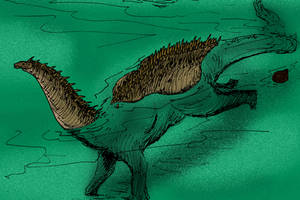ShopDreamUp AI ArtDreamUp
Deviation Actions
Suggested Deviants
Suggested Collections
You Might Like…
Featured in Groups
Description
Another monthly contest (COM #43) begins on the Speculative Evolution forum (s1.zetaboards.com/Conceptual_E….
EDIT: Podorhinus inconspicuus just won the contest with 6 votes on 9!
Creepsnout (family Podorhinidae)
«Several populations of feral pigs survived easily in the absence of their former masters, and quickly overcame many different species of mammals weakened by millennia of human activity, at the point of having to compete against themselves in most land ecosystems. After 50 million years without significant human intervention, their descendants branched and splintered into a multitude of forms that specialized to survive on a variety of resources. Here in Africa there are roaming elephant pigs and lanky giraffe pigs and idle manatee pigs and fearsome hyena pigs, but we won't be concerned with them. Rather, we will look in the short grass to find the unconspicuous burrows of the creepsnouts.
EDIT: Podorhinus inconspicuus just won the contest with 6 votes on 9!
Creepsnout (family Podorhinidae)
«Several populations of feral pigs survived easily in the absence of their former masters, and quickly overcame many different species of mammals weakened by millennia of human activity, at the point of having to compete against themselves in most land ecosystems. After 50 million years without significant human intervention, their descendants branched and splintered into a multitude of forms that specialized to survive on a variety of resources. Here in Africa there are roaming elephant pigs and lanky giraffe pigs and idle manatee pigs and fearsome hyena pigs, but we won't be concerned with them. Rather, we will look in the short grass to find the unconspicuous burrows of the creepsnouts.
Creepsnouts descend from a group of small-sized post-pigs that specialized as insectivores. Their elongated snout developed appendages refined enough to sense and hold individual ants and beetles, and then allowed the animal to control them independently with a new set of muscles, anchored on a ring of cartilage. As the ancestral creepsnouts grew smaller, their snouts became longer, more mobile and sensitive, endowed with bands of muscles and an almost spine-like cord of cartilage "bones". Today, the snout is easily twice or even three times as long as the rest of the body. In order to avoid the constant danger of the hyena pigs and the stalking ground raptors, they learned to spend most of the day quietly hidden in their burrows, in rotting tree-trunks or under piles of leaves, leaving only their snout exposed, as it prowled the ground almost by itself.
The tip of the snout is almost a second head, richer in nerve endings than any other mammalian organ, with its muscular "fingers", its folded nasal cavities (by now used only for smelling: the snout is too long to carry reliably air to the lungs) and its array of tactile hairs and gustatory papillae. Smelling, tasting and touching the ground, the snout doesn't need eyes or ears to find preys with deadly effectiveness. Of course, the snout itself remains exposed to predators, but even then it's not entirely defenseless: the flat tip, where the nostrils are found, can act as a sucker ripping fur and feathers, or even drawing blood, from the enemy.
Today, there are about a hundred species of creepsnouts. The largest is a meter long and a couple kg heavy; the smallest, less than 5 cm long and only a few grams heavy. In every continent, except for Antarctica and Lemuria, there's scarcely a forest floor, a scrubland, a grassland, a savannah, a meadow or a tundra where the ground isn't animated by tiny fleshy ribbons prowling for insects and lizards. One could speculate that someday the descendants of the creepsnouts will colonize the shores and turn their snouts in fishing rods, or developing their suckers and turning against their predators to become mammalian leeches, or become fully sessile and exile themselves underground like monstruous tubers; but that lies far in the future. For now, creepsnouts work perfectly the way they are.»
The tip of the snout is almost a second head, richer in nerve endings than any other mammalian organ, with its muscular "fingers", its folded nasal cavities (by now used only for smelling: the snout is too long to carry reliably air to the lungs) and its array of tactile hairs and gustatory papillae. Smelling, tasting and touching the ground, the snout doesn't need eyes or ears to find preys with deadly effectiveness. Of course, the snout itself remains exposed to predators, but even then it's not entirely defenseless: the flat tip, where the nostrils are found, can act as a sucker ripping fur and feathers, or even drawing blood, from the enemy.
Today, there are about a hundred species of creepsnouts. The largest is a meter long and a couple kg heavy; the smallest, less than 5 cm long and only a few grams heavy. In every continent, except for Antarctica and Lemuria, there's scarcely a forest floor, a scrubland, a grassland, a savannah, a meadow or a tundra where the ground isn't animated by tiny fleshy ribbons prowling for insects and lizards. One could speculate that someday the descendants of the creepsnouts will colonize the shores and turn their snouts in fishing rods, or developing their suckers and turning against their predators to become mammalian leeches, or become fully sessile and exile themselves underground like monstruous tubers; but that lies far in the future. For now, creepsnouts work perfectly the way they are.»
Image size
1700x1300px 1.61 MB
© 2014 - 2024 Concavenator
Comments4
Join the community to add your comment. Already a deviant? Log In
i'm reminded of the rhinogrades



































